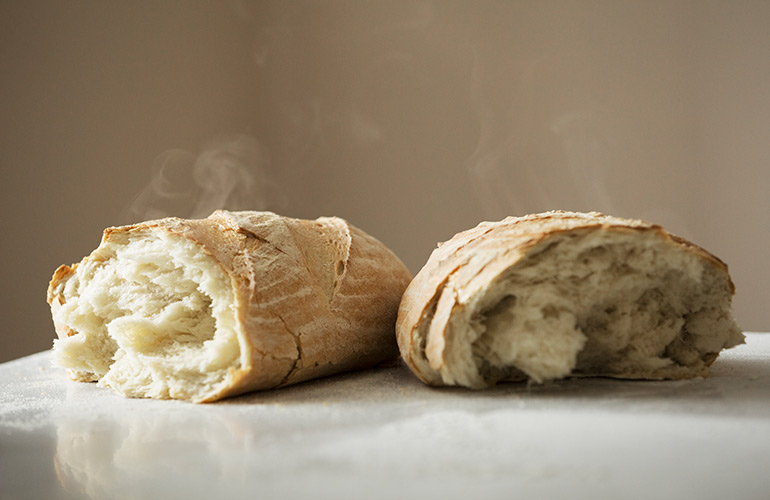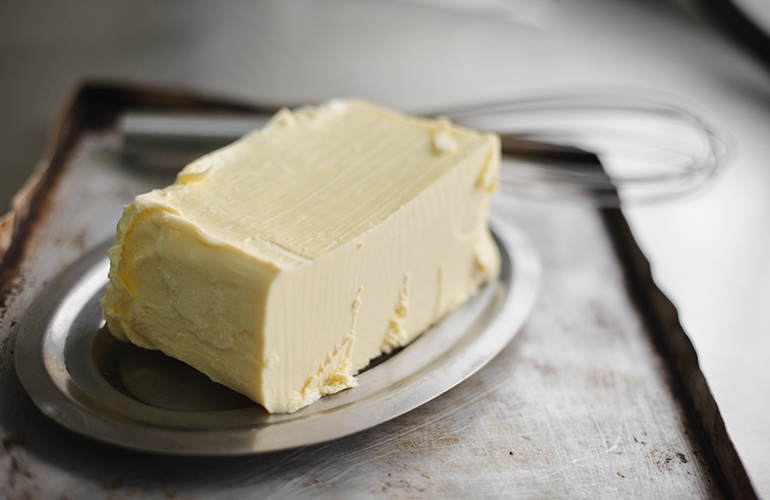
My introduction to baking started with the home-kitchen classic that cracks open the oven door for so many – chocolate chip cookies. It was the 1970s, and most of the mums in our largely Catholic neighbourhood were busy raising big families. For the girls in my house, that meant our mother made sure we knew our way around the kitchen. At the flour-dusted table, Mum taught eight-year-old me how to make the cookies perfectly chewy with a crispy exterior. (The big secret: Always chill your dough.)
We crafted them by the dozen, measuring ingredients from yellow Tupperware containers and mixing everything in my mum’s aqua Butterprint Pyrex bowl, part of a set she’d received as a wedding gift in 1963. Friends who grew up in “fresh fruit is dessert” households could not get enough when they visited. And if they happened to come over when the cookie jar was empty, they were not shy about sharing their disappointment.
So from a young age, I was crystal clear on the power of a baked-to-perfection cookie to make people happy. Baking cookies – then brownies, cakes and pies – became my hobby and a tasty form of social currency. First I used my skills with butter and sugar to impress a series of teenage boyfriends. In time, the fresh goodies were left on doorsteps to welcome new neighbours and set out in the break room for co-workers. Baking was my superpower.
A few years ago, I became the content director for Taste of Home, Reader’s Digest’s sister magazine and website that celebrates the treasured recipes of home cooks. I’d never been more excited for a new job, but privately I worried that my baking chops wouldn’t measure up. Why? I had a secret as dark as an oven with a burned-out light bulb: While I had baked sweets my whole life, I’d never made a yeast bread from scratch.
Mum couldn’t help me with this one. For her, store-bought frozen dough was her go-to when she needed “from scratch” bread. I understand why: Bread dough provides so many opportunities to fail. Cookies are forgiving. You can be a little off in your measurements, and, trust me, those cookies still disappear from the office break room. Not the case with yeast breads. Most recipes recommend weighing ingredients carefully, down to the gram.
Then there’s the yeast. Yeast is fussy, the Goldilocks of ingredients. Mix it in water too cool and it won’t activate; too hot, and it dies. Yes, yeast is a living, one-celled member of the fungus family. Because it is alive, I could, of course, kill it – and unfortunately rather easily.
And don’t forget that other potential failure point: the kneading. Too little kneading and the bread will be flat. But don’t overdo it! Knead it too much, and the loaf will be tough and chewy.
Still, this was no time for excuses. I was a baker, now one with Taste of Home attached to my name. I may have been intimidated by bread, but it was time. I wanted in.
Getting started, I found Instagram to be a friend. A basic no-knead bread was the one I was seeing online overlaid with dreamy filters. People described it as easy, and to be honest, the thought of removing even one intimidating variable – kneading – was enough to get me to buy two kilograms of bread flour and dive in.
I gathered everything I’d need (“be prepared” is the first rule of any baking), including my mum’s trusty Pyrex. It had seen me through my first days as a baker, so I was counting on it to work its magic. I had an easy Taste of Home recipe all set on my iPad. I mixed the flour, salt, and yeast and made sure the water temperature was just right – 38 to 46 degrees – before pouring it in.
And then it happened – or didn’t happen. I followed the instructions to the letter, but my dough didn’t rise. Somehow, impossibly, it looked smaller. Sludgy, gooey, wet with a few bubbles. Sad.
The Pyrex bowl didn’t save me, so I had to figure out how to do it myself. Frantically googling “bread dough didn’t rise” yielded a likely answer – the room was too cold. But I found some solutions too. I put the disappointing dough in the oven with the light on, a trick that provides just a bit of gentle heat, to let it try again.
Three hours later, after I’d resisted the urge to keep checking on it like a nervous mum with a newborn, a puffy dough filled the bowl. I hadn’t killed it; it was just … sleeping. A quick fold, a second rise, and then my bread went into my Dutch oven and off to bake.
Thirty minutes later, I took it out. Sure, it was slightly misshapen, but in my eyes, it was golden-brown, crusty perfection, right down to the yeasty-sweet hit of steam coming from its top.

Naturally, the first thing I did was grab my phone and hop on Instagram, positioning my beautiful bread just so in a shining stream of daylight on a wooden cutting board. No one needed to know it was my first yeast bread ever – or how close it came to getting scraped into the garbage can. The online reactions started almost immediately – heart emojis and comments like “This looks DELISH!” from my friends.
They couldn’t taste it, but virtual sharing yields its own rewards.
Finally I cut into that lovely brown crust and doled out slices to my husband and kids. Those slices led to seconds, then thirds, each piece slathered with softened butter and a little sprinkle of salt. I made my family perhaps happier with slices of warm, buttered homemade bread than I had with all the sweets combined. They were used to the cookies and brownies; this was something totally new and equally delicious. Soon enough, I was left with a butter-smeared knife, a few lonely crumbs on the cutting board, and, of course, my post on Instagram as the only evidence of its existence.
At last, I was a bread baker – despite yeast’s best attempts to intimidate me on this first try. No more feeling inferior or afraid. Now I make bread and homemade pizza crust regularly. Yeast and I have such a good relationship that I’m done buying the little packs – I buy it in large enough quantities to fill its own Tupperware container. And I have enough confidence to start thinking (and stressing!) about my next difficult baking challenge: homemade croissants.
Tips from my trial and error
- Read the whole recipe before you start.
We’ve all gotten halfway through a recipe only to find we don’t have any buttermilk. Plus, a quick read can help you prepare for what’s ahead, particularly if there are any techniques with which you’re not familiar.

- Use butter at the right temperature.
Most cake and cookie recipes call for softened butter, which is the right consistency for creaming with sugar. Biscuit and pie pastry recipes call for ice-cold butter in order to create the flakiest layers. If your butter isn’t the correct temperature, your bakes won’t mix up the way they should.
- Weigh all your ingredients.
When it comes to baking, it’s always preferable to measure your ingredients by weight rather than volume. This ensures you get exactly the right proportions. It may not be critical for something simple like a pan of brownies, but it’s important with fussier baked items, such as macarons.
- Chill cookie dough.
We know how tempting it is to get your cookies in the oven the second you’re done mixing up your dough. However, chilling the dough can help develop flavours and prevent cookies from spreading too much. Do not skip this step!
- Coat mix-ins with flour.
When a recipe calls for add-ins (dried fruits, chocolate chips, and/or nuts), you’ll often see instructions to toss them in a bit of flour before adding to the batter. You might think that’s a waste – after all, there’s flour in the batter. But coating these heavy mix-ins helps prevent them from sinking to the bottom of the pan. The extra step gives you even distribution and a prettier result.
- Cool cakes completely before icing.
Always let your cakes, cupcakes, and cookies cool completely before icing them. If they are too warm, the icing will slide right off the top of your cake or melt and soak in. Cooling racks speed up the process. If you don’t have one, take the cover off your ironing board and use the board as a cooling rack.
Sign up here to have Reader’s Digest’s favourite stories delivered straight to your inbox.
Source: RD.com







